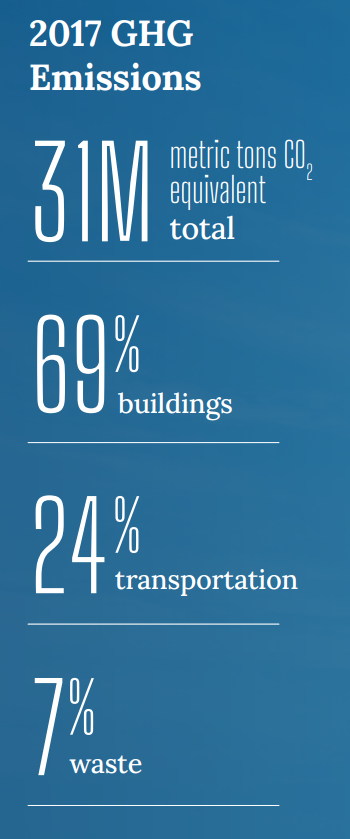Electrify Chicago
An independent tool for viewing City of Chicago building data
According to the
2022 Chicago Climate Action Plan,
69% of Chicago's emissions come from buildings, making
building emissions our biggest challenge and our biggest opportunity as a city
to tackle climate change. At Electrify Chicago, we showcase building performance using
publicly available data supplemented by community-submitted photographs and building
owners.
Start by looking at Chicago's buildings with the highest greenhouse gas intensity i.e. emissions per square foot. Large, efficient, buildings can perform much better than very inefficient small buildings on this metric.
New Article
📰 $30 Million In Missed Fines
The City Of Chicago failed to collect $30 million in potential fines from the building benchmarking ordinance, reducing transparency and accountability.
Legislative update! 🎉
As of late January 2024, legislation is being introduced to require new use more efficient forms of water and space heating, via the Clean And Affordable Buildings Ordinance (CABO), which will reduce the number of highly polluting and inefficient buildings that end up on this site.
If you're in Chicago,
write to your alderman to support the CABO!
Chicago Buildings by Greenhouse Gas Intensity
Note: Data includes large Chicago buildings with data from 2022, unless explicitly stated otherwise.
Note: This data only includes buildings whose emissions are reported
under the
Chicago Energy Benchmarking Ordinance. According to the City “As of 2016,
this list includes all commercial, institutional, and residential buildings larger than
50,000 square feet.” This dataset is also then filtered to only buildings with
reported emissions > 1,000 metric tons CO2 equivalent.
The latest year of data is from 2022, but we update the site regularly when new data is available, and some buildings may have failed to report that year, and only have older data available.
| Property Name / address | Primary Property Type |
Greenhouse Gas Intensity (kg CO2 eq./sqft) |
Total Greenhouse Emissions (metric tons CO2 eq.) |
|---|---|---|---|
|
Dumas Elementary -CPS
(CPS)
6650 S Ellis Ave
| K-12 School | 5.8 kg/sqft
Lowest 39%
| 375 tons
Lowest 15%
|
|
Motley School Apartments
🕰️
739 N Ada St
| Multifamily Housing | 5.8 kg/sqft | 331 tons |
|
The Theatre School
(DePaul)
2350 N Racine Ave
| College/University | 5.8 kg/sqft
Lowest 39%
| 941 tons
Highest 47%
|
|
720 W. Gordon Terrace CA
720 W Gordon Ter
| Multifamily Housing | 5.8 kg/sqft
Lowest 39%
| 1,662 tons
Highest 28%
|
|
Jackson Shore Co-op
5490 S Shore Dr
| Multifamily Housing | 5.8 kg/sqft
Lowest 39%
| 578 tons
Lowest 32%
|
|
3800 N. Lake Shore Drive
3800 Lake Shore Dr
| Multifamily Housing | 5.8 kg/sqft
Lowest 39%
| 1,434 tons
Highest 33%
|
|
110 E Delaware
110 E Delaware
| Multifamily Housing | 5.8 kg/sqft
Lowest 39%
| 937 tons
Highest 47%
|
|
Wicker Park Apts
(CHA)
1414 N Damen Ave
| Multifamily Housing | 5.8 kg/sqft
Lowest 39%
| 1,108 tons
Highest 42%
|
|
(IL526)-Carl Sandburg Village
1355 N Sandburg Ter
| Multifamily Housing | 5.8 kg/sqft
Lowest 39%
| 4,175 tons
Highest 9%
|
|
University Station CA
1550 S Blue Island Ave
| Multifamily Housing | 5.8 kg/sqft
Lowest 39%
| 1,719 tons
Highest 27%
|
|
474 North Lake Shore Drive
474 N Lake Shore Dr
| Multifamily Housing | 5.8 kg/sqft
Lowest 39%
| 3,248 tons
Highest 12%
|
|
345 Fullerton Parkway Condominium Association
345 W Fullerton Pkwy
| Multifamily Housing | 5.8 kg/sqft
Lowest 39%
| 1,691 tons
Highest 28%
|
|
Jazz on the Boulevard
(CHA)
4659 S DREXEL BLVD
| Multifamily Housing | 5.8 kg/sqft
Lowest 39%
| 838 tons
Lowest 48%
|
|
1055 W CATALPA AVE
1055 W CATALPA AVE
| Multifamily Housing | 5.8 kg/sqft
Lowest 39%
| 393 tons
Lowest 16%
|
|
2617 2625 W GUNNISON ST
🕰️
2617 2625 W GUNNISON ST
| Multifamily Housing | 5.8 kg/sqft | 569 tons |
Data Source:
Chicago Energy Benchmarking Data
